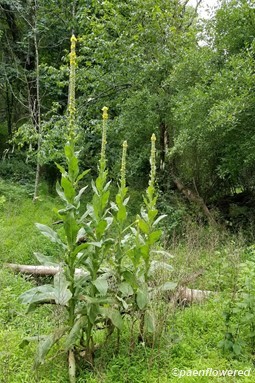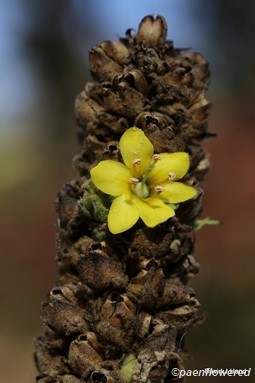Verbascum thapsus
A tall European biennial import growing up to 7 feet
Verbascum thapsus common mullein
This biennial plant of the figwort family is another alien import from Europe that has become widespread in North America. It is quite variable in size. Some grow only about 1 foot tall, but there are also seven-foot giant plants that look like something prehistoric. From a distance this species doesn’t look like much, but does produce attractive flowers that can be seen if you get close.
The first year the plant produces only a simple rosette of leaves near the ground; the second year it sends up a tall, thick flower spike (raceme). It is densely packed with saucer-shaped, yellow flowers that are ¾ to 1 inch in diameter. There are five stamens and one pistil. These flowers have five petals that are covered on the back with whitish hairs. The flowers have short stalks or no stalks and thus seem attached directly to the spike.
The flowers are pollinated by bees or self-pollinated if no insects are available. These flowers last only one day and bloom only a few at a time, from the bottom to the top of the stalk. This extends blooming time from June through September. One plant can produce a tremendous number of seeds in one season—about 200,000—and these can remain viable in dry soil for up to a hundred years. The dead stalk can persist through the winter.
The leaves of the common mullein are large, thick and wooly and vary in size and shape. The larger leaves, though, tend to be at the bottom. As with many alien species, the common mullein grows in disturbed ground: roadsides, poor fields, vacant lots and even on the sides of cliffs. The tiny seeds germinate best on bare soil in full sunlight.
The plant has a variety of practical uses. Roman soldiers used to dip the flower stalks in grease and use them for torches. Colonists in America used the leaves as winter insulation in their shoes and socks. A medicinal tea can be made from the leaves and traditionally was used to treat respiratory problems. The leaves have been applied to the skin to ease sunburn and other inflammation. In America, Quaker girls, who were forbidden from using makeup, rubbed the slightly abrasive leaves on their cheeks to produce a pleasant skin glow. The flowers have been used to make dyes, especially for the hair.
Habitat & Range
Common in fields, roadsides, waste grounds.
Present throughout the state.
| EMP: | FACU |
|---|---|
| NCNE: | UPL |
Phenology
Flowers June to September.










Comments
Have you spotted this plant in your area? We'd love to hear about your experience! Share your comments or questions about the plant below. Comments are moderated before posting.